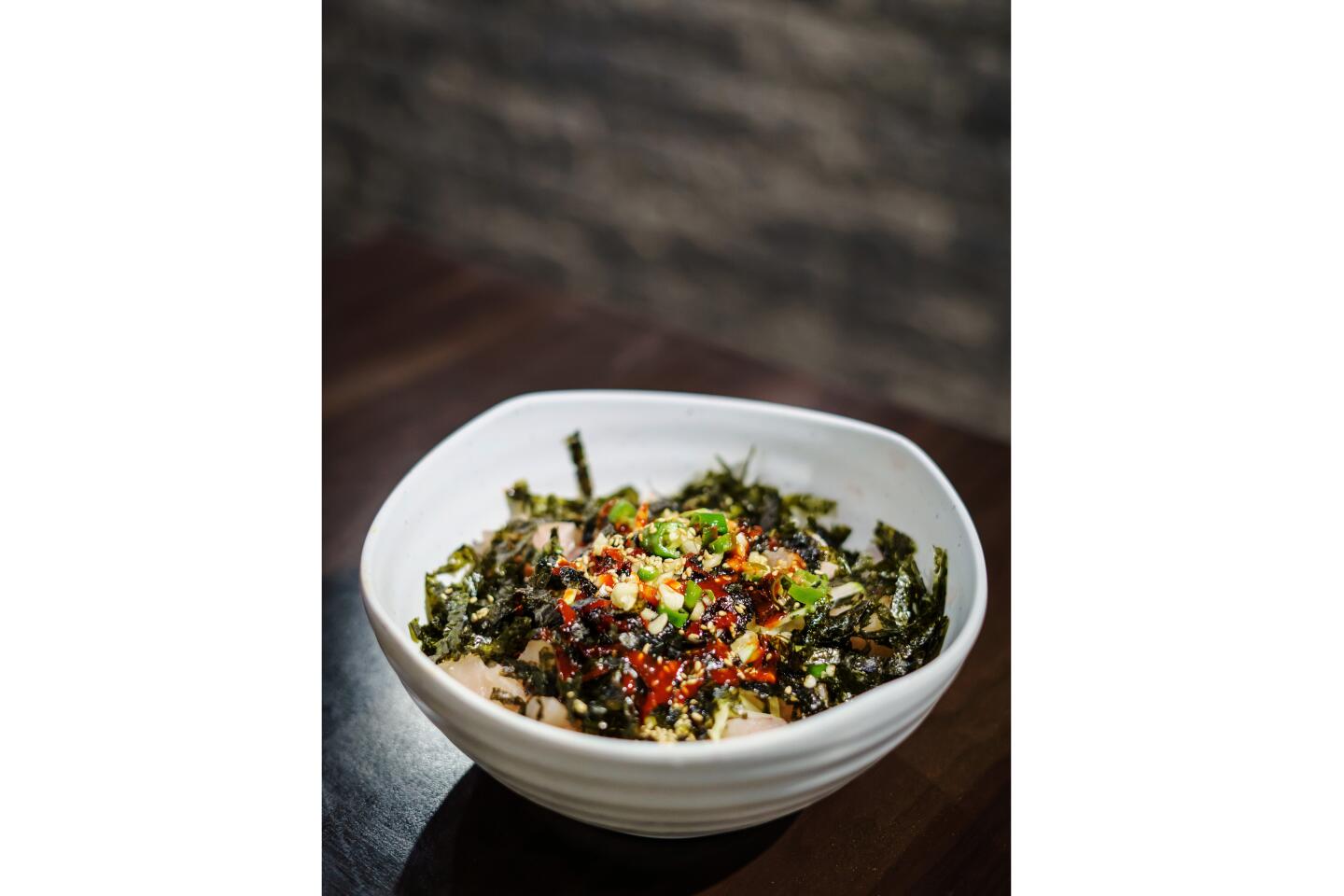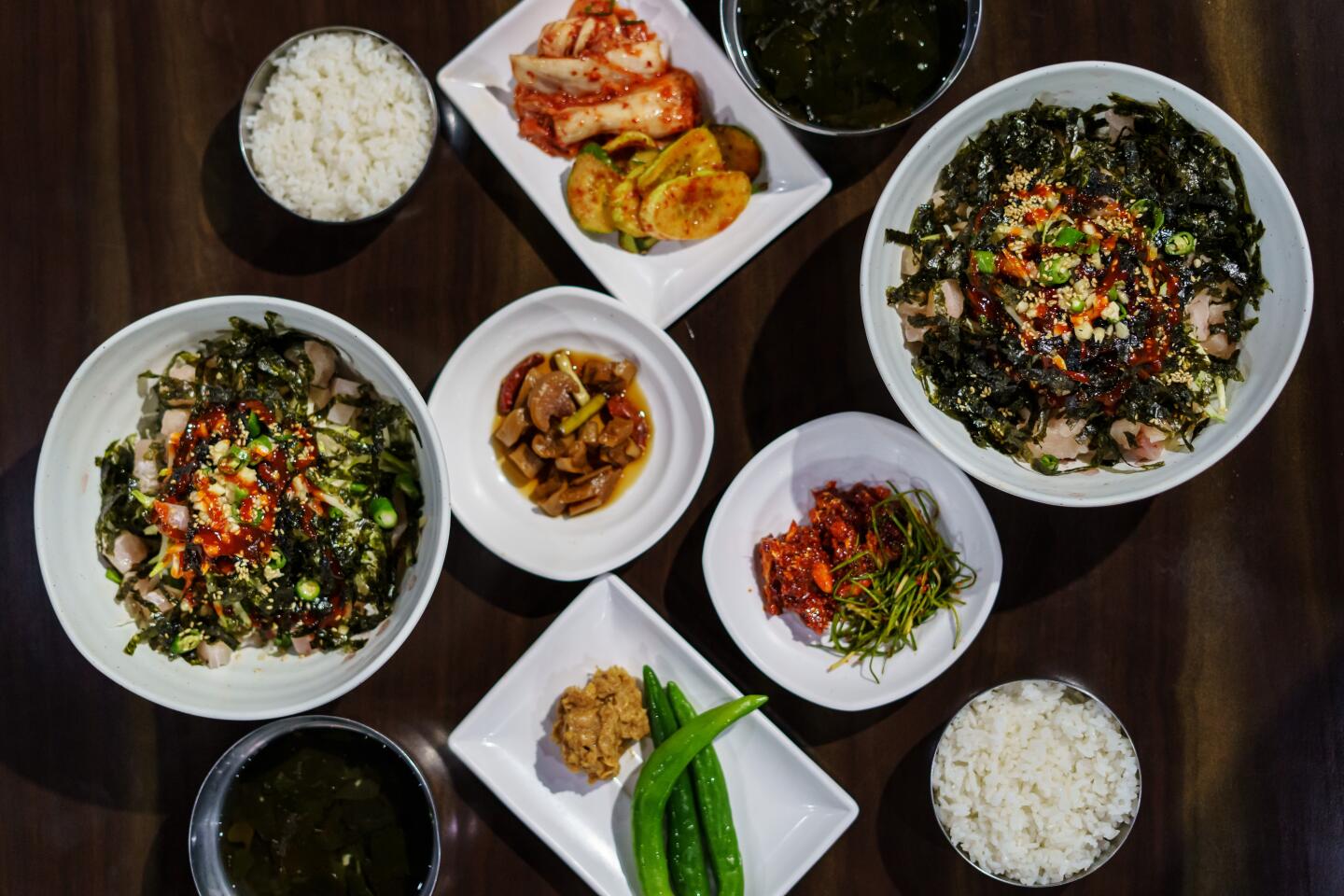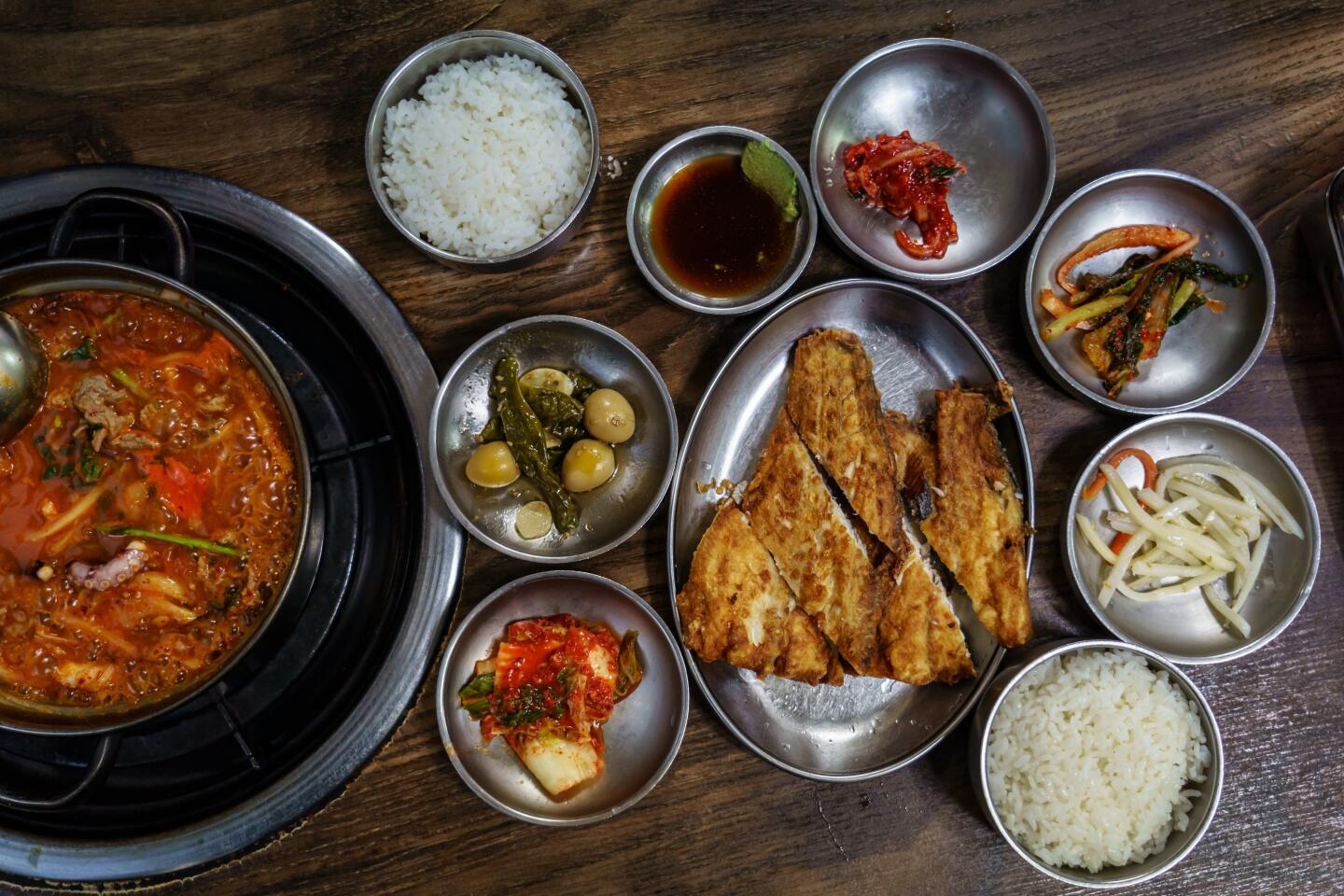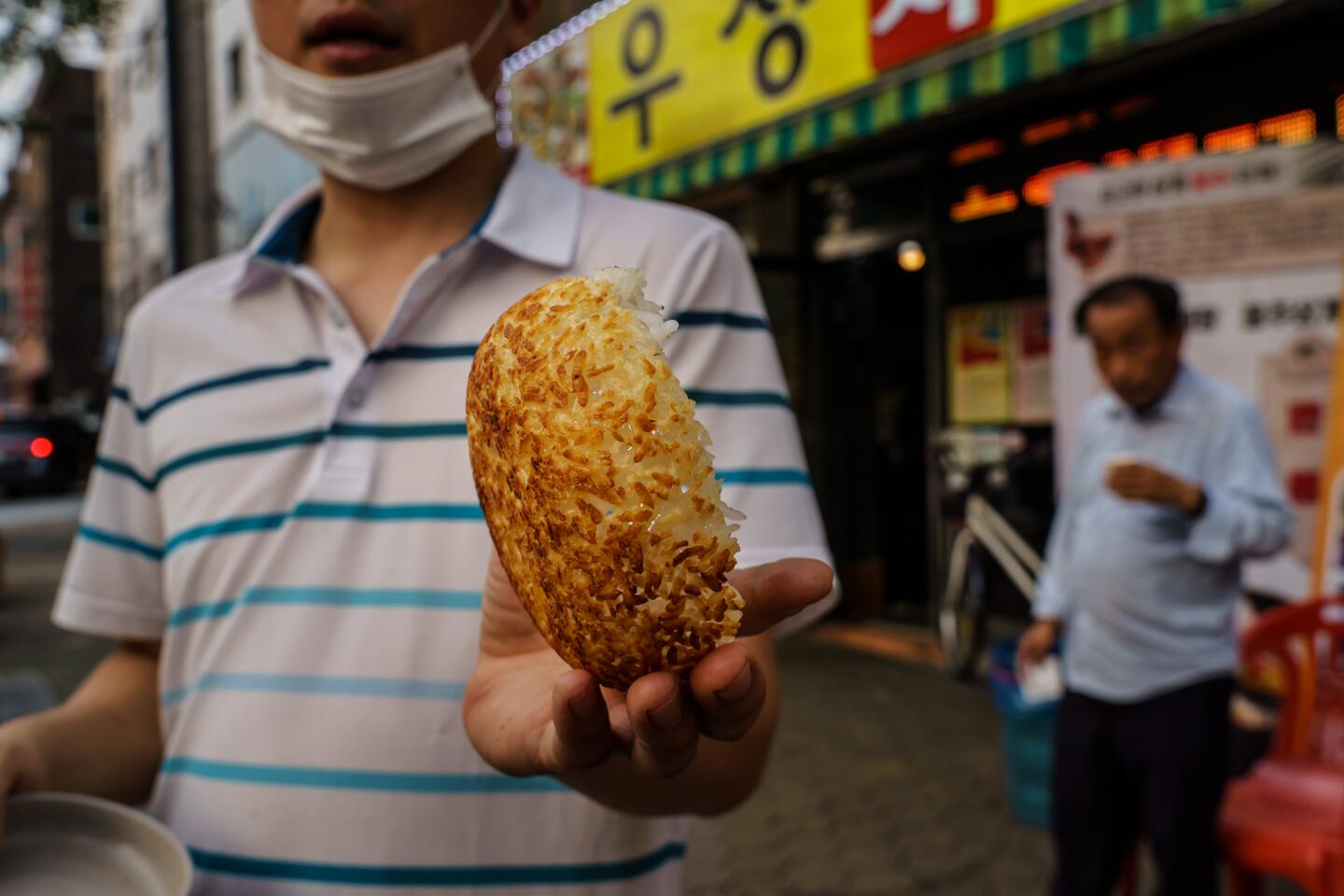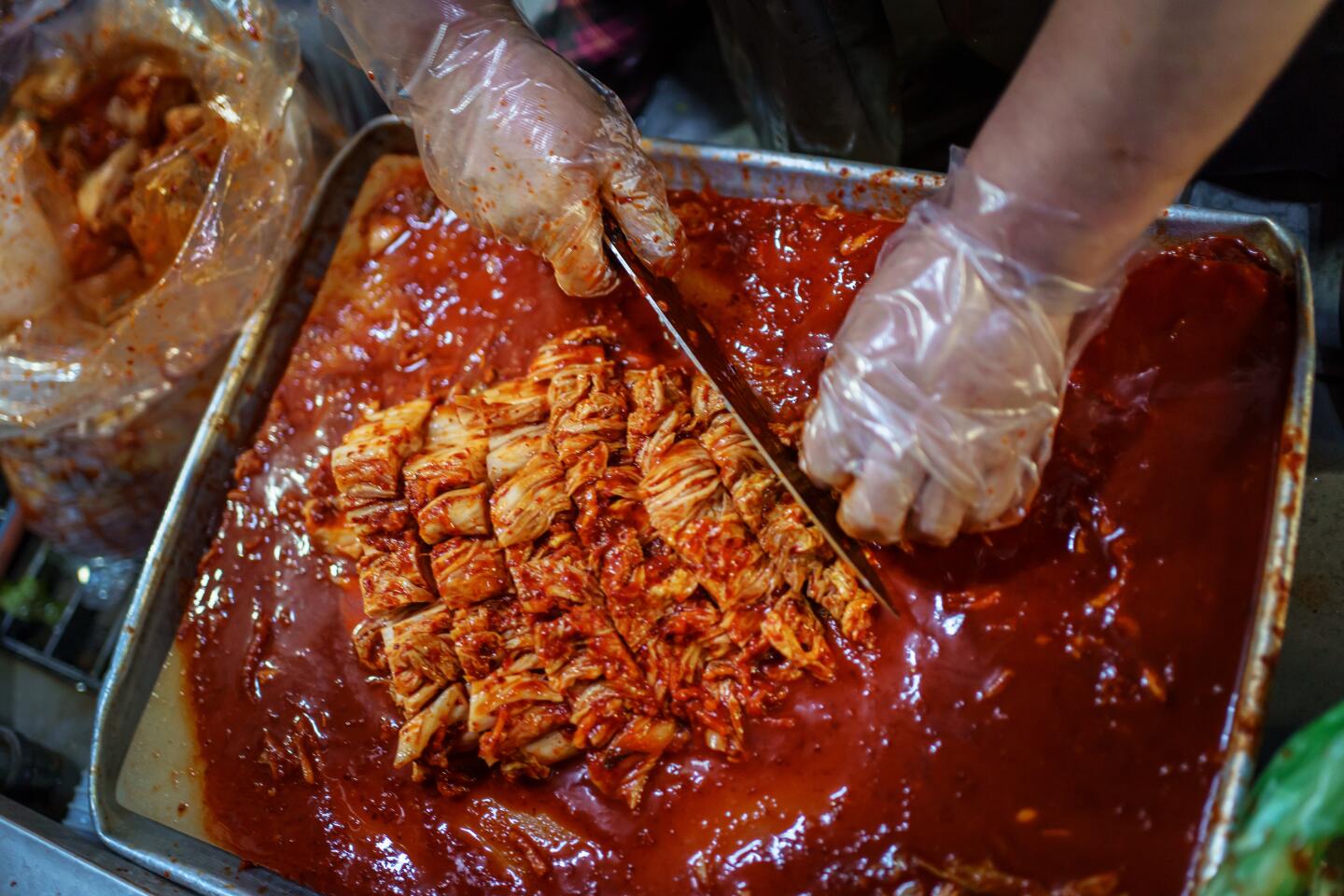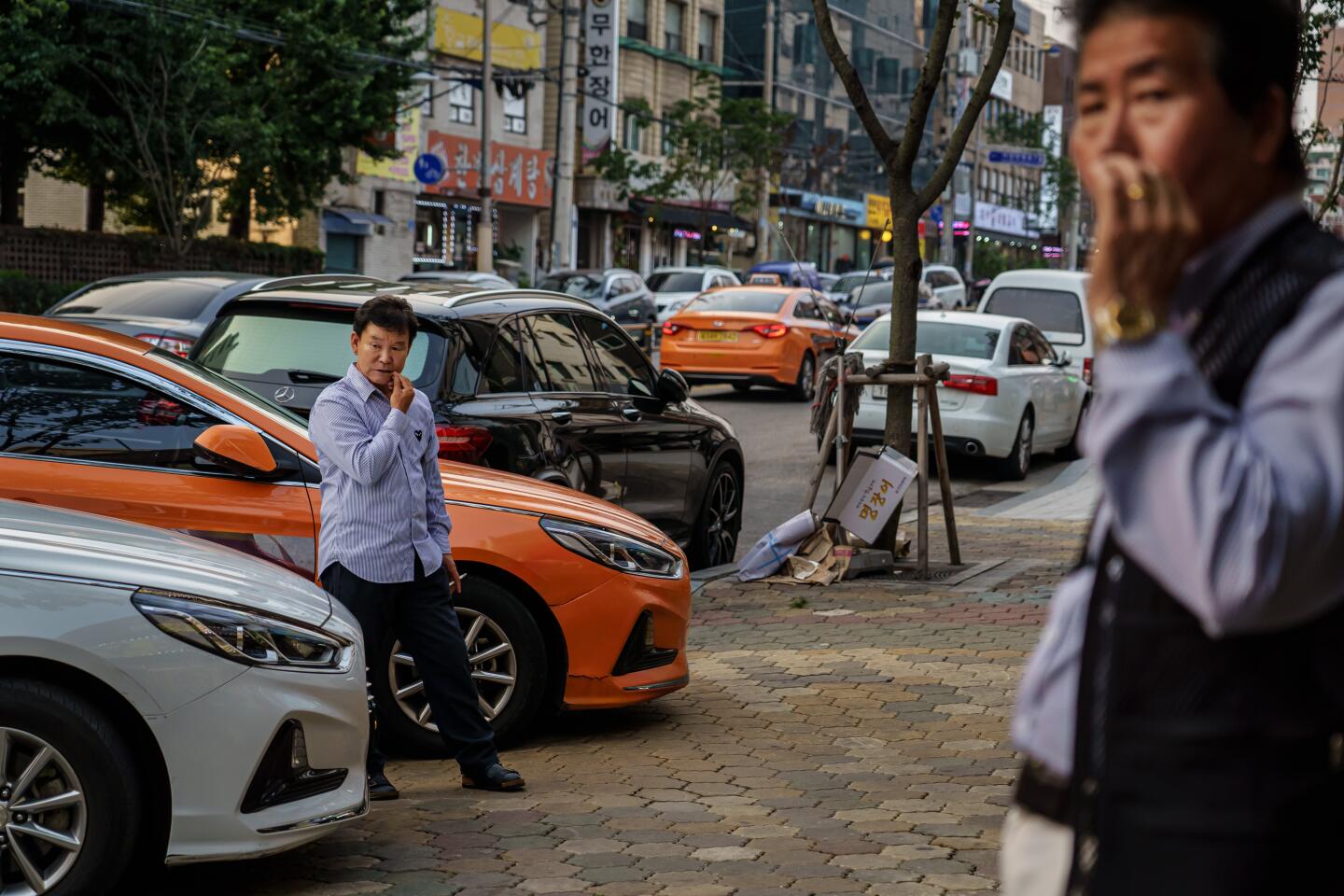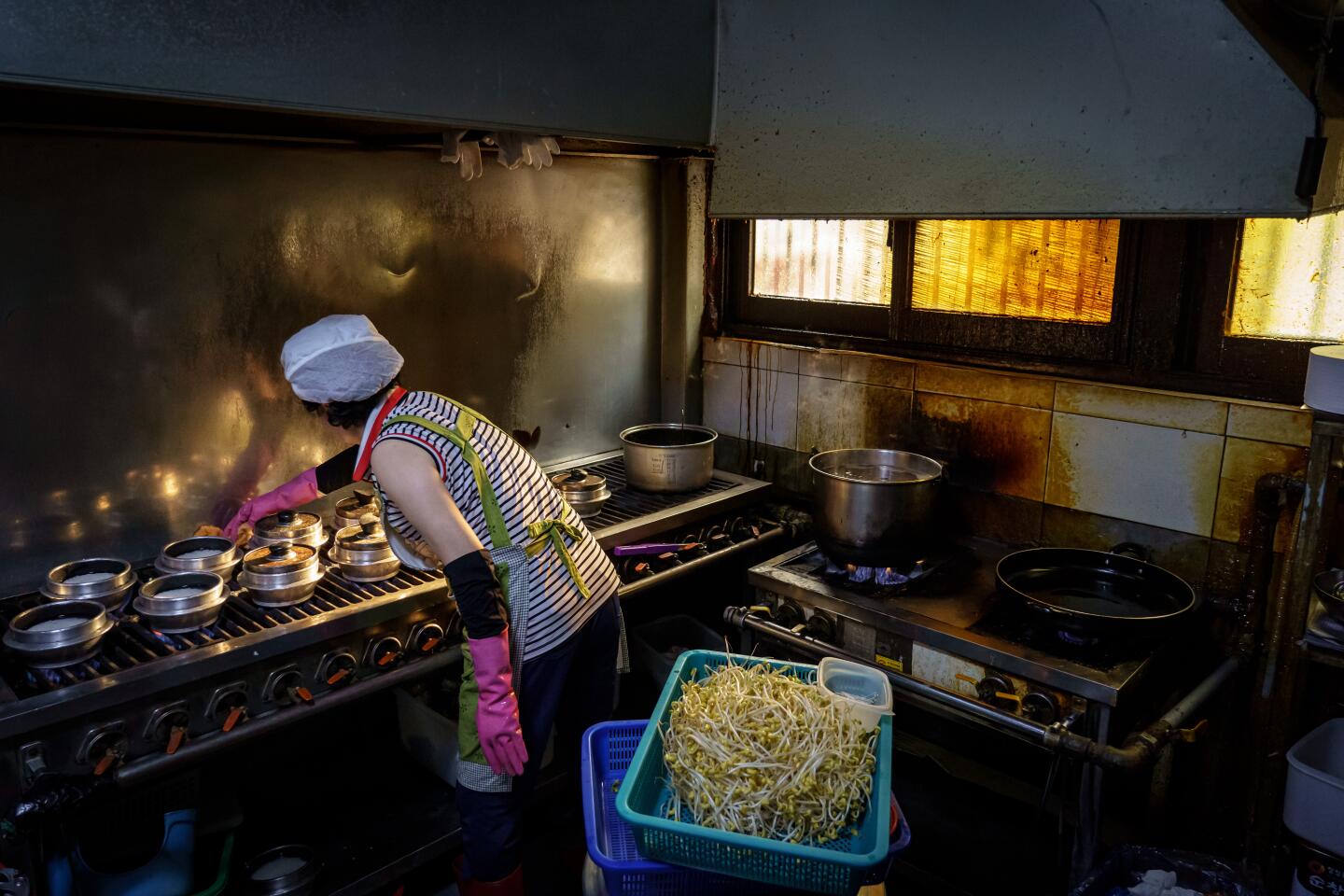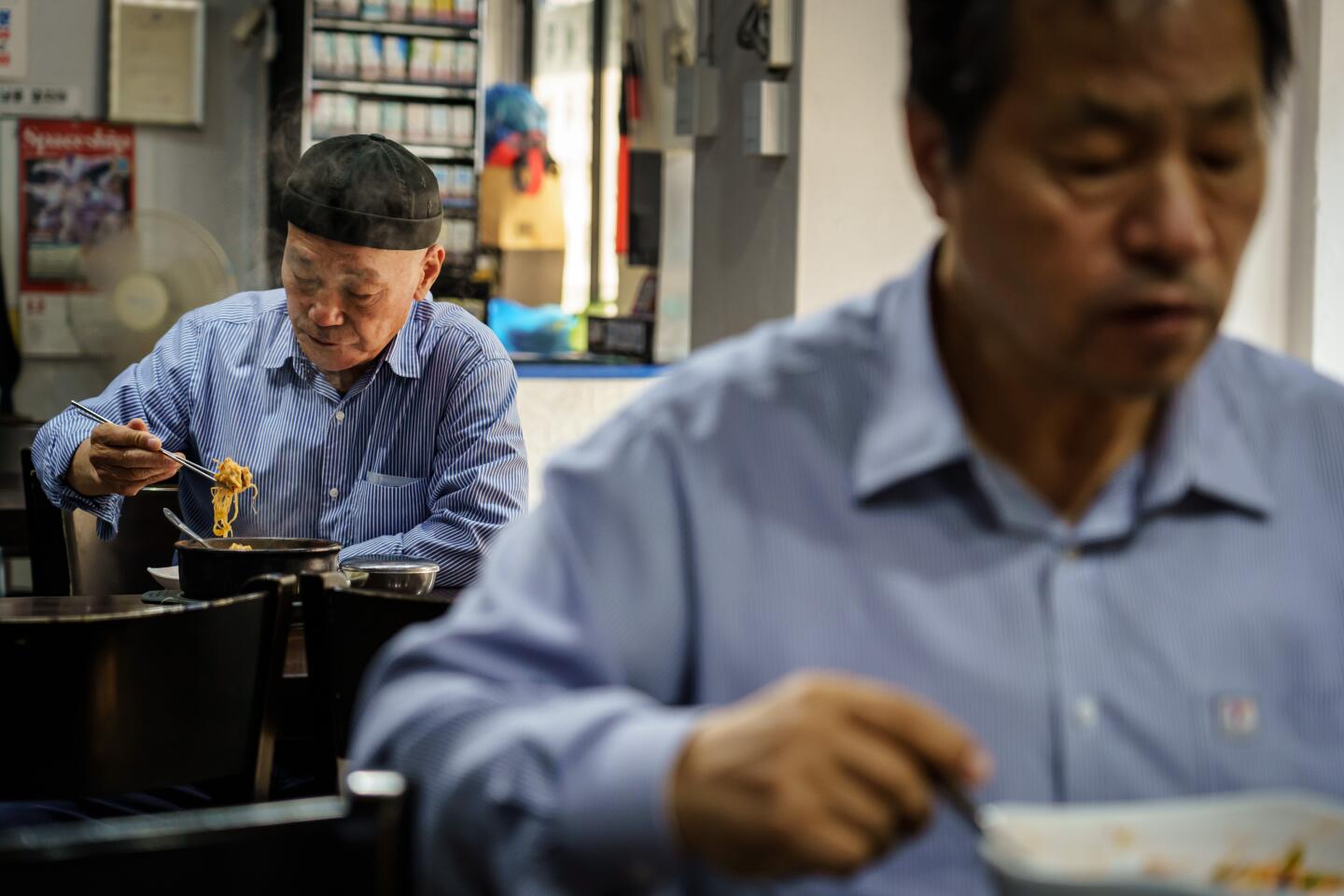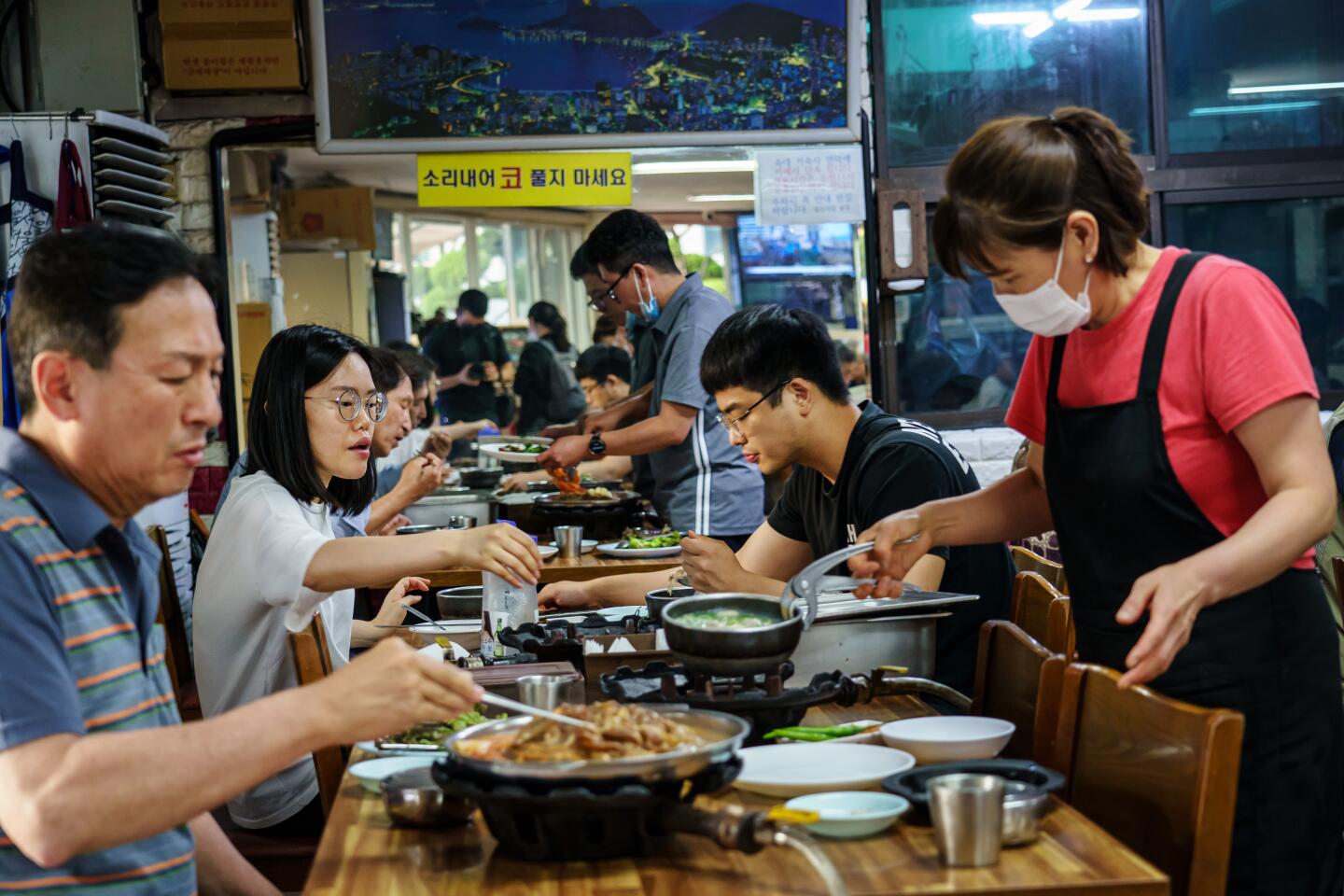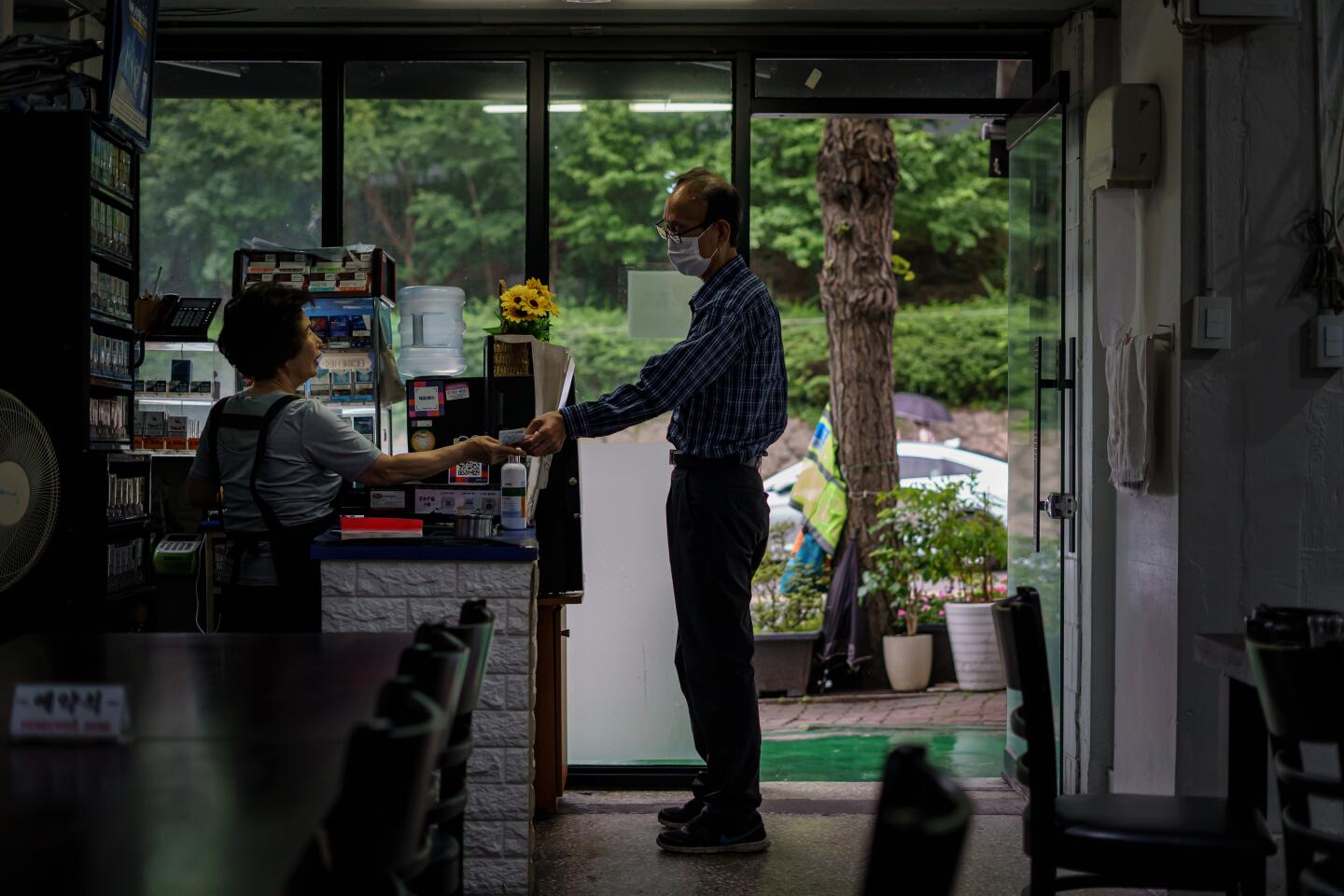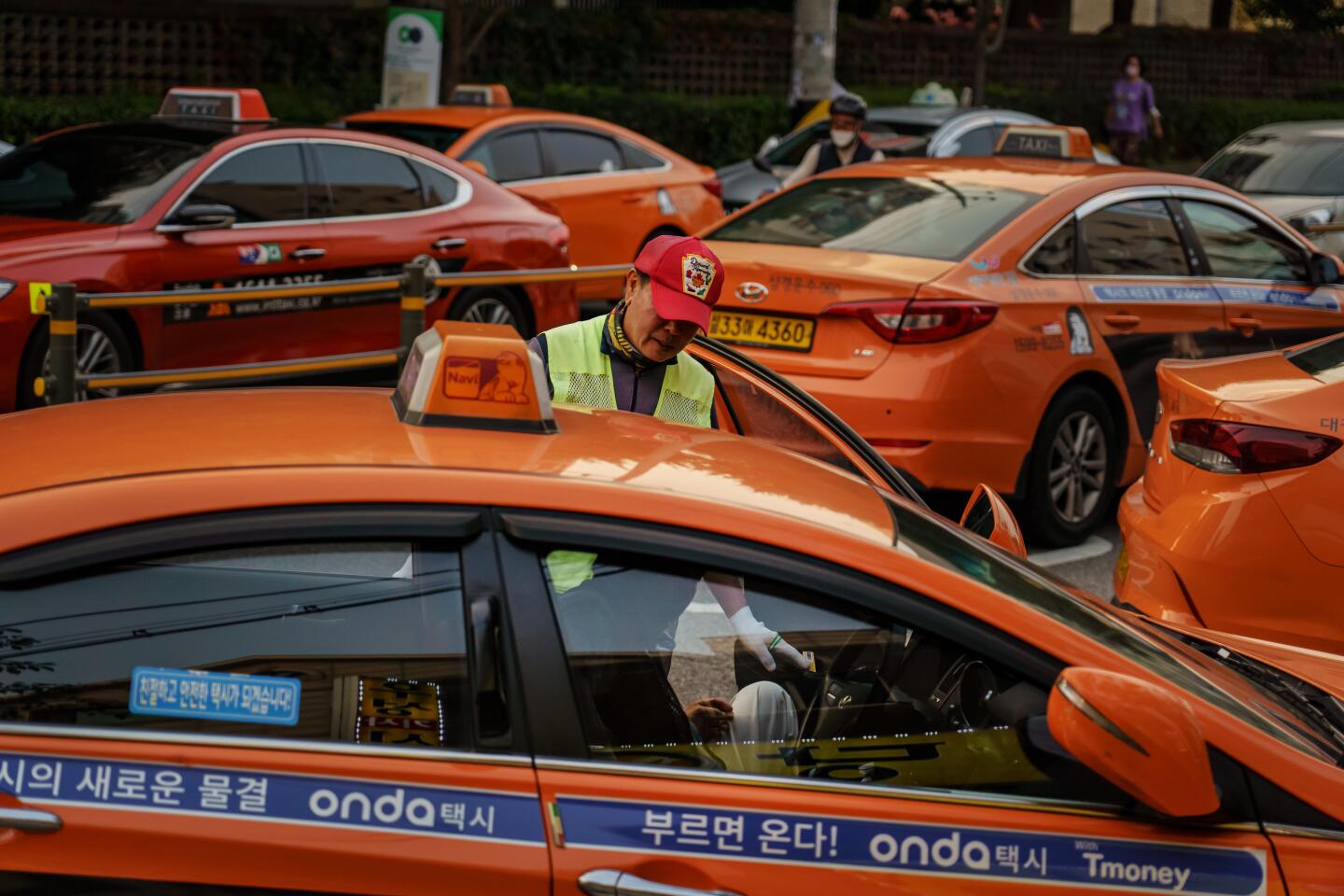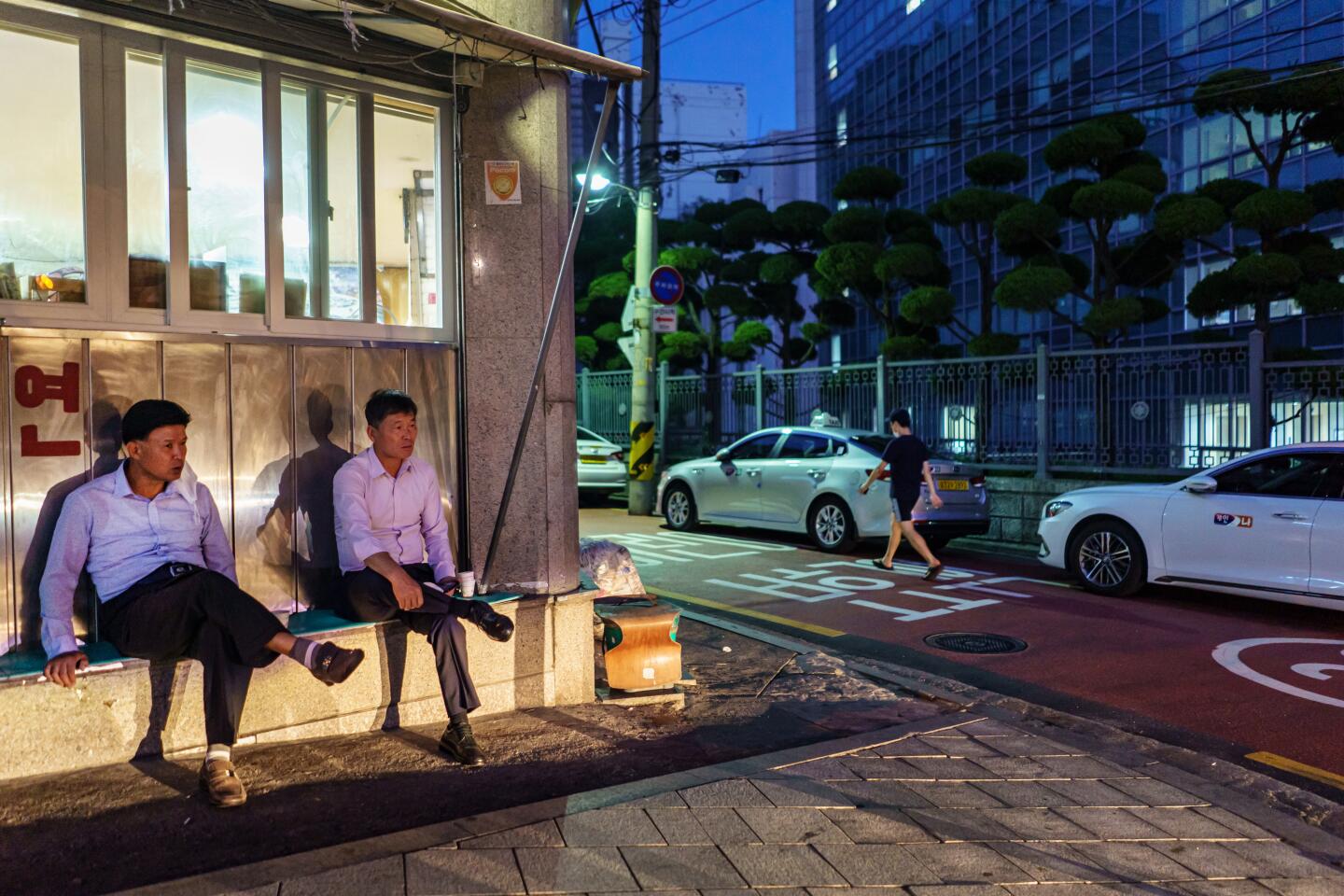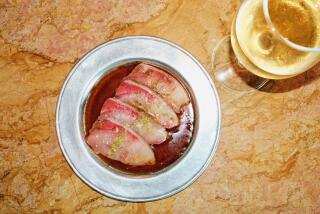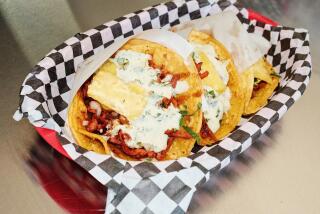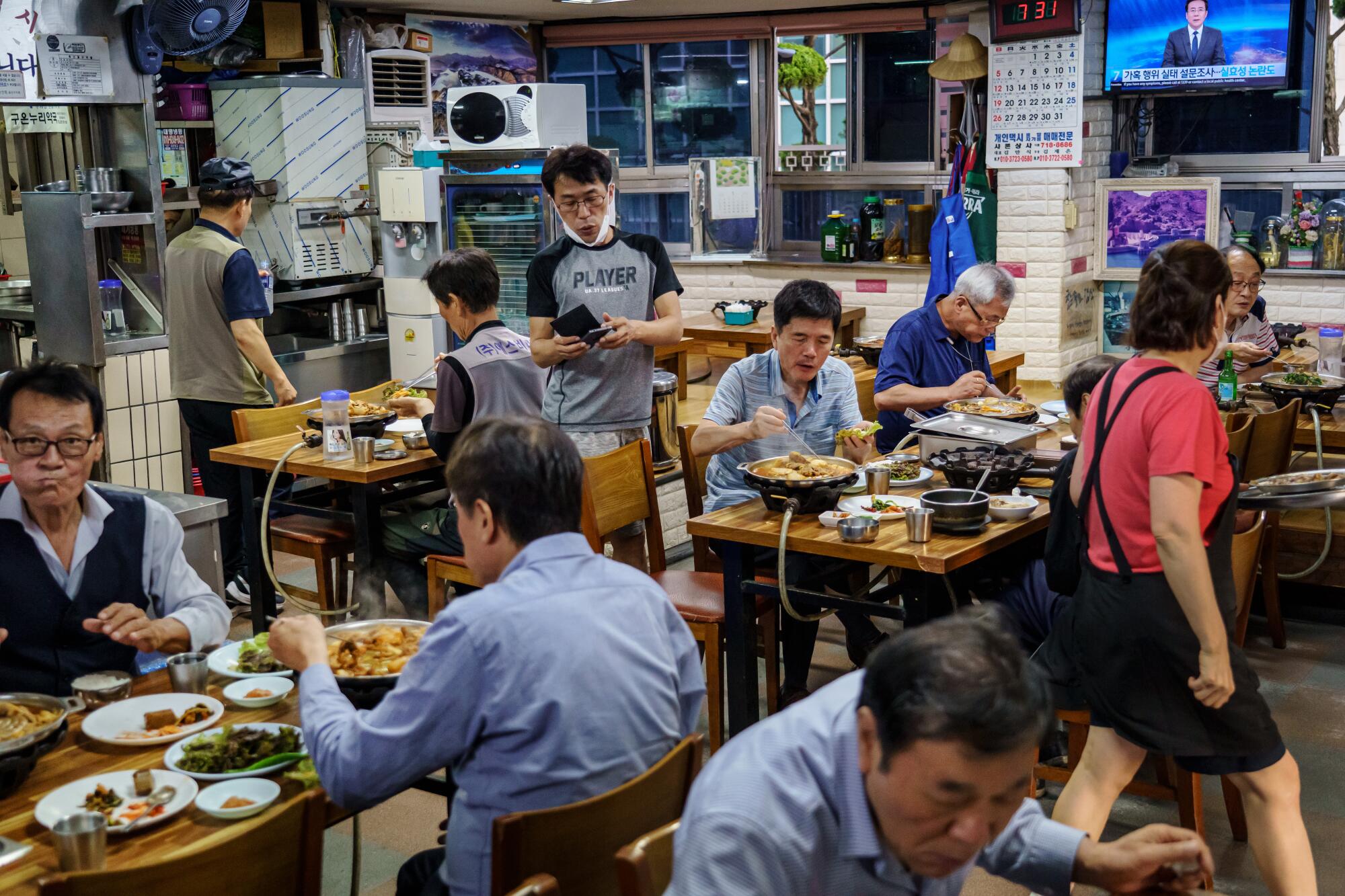
- Share via
SEOUL — It’s 4 p.m., that unclaimed time between lunch and dinner when most restaurants in Seoul are on their post-lunch break, happy hour still seems an eternity away and office workers daydream about their impending escape.
Shin In-kyun dumped a steaming bowl of white rice into a nest of vegetables and raw tuna, churning the hwedupbap in a bright red sauce until he got an even distribution to his liking. He heaped a spoonful, topped it with a piece of cucumber kimchi and took a bite.
Shin has been coming to this humble eatery, Suncheon Gisa Sikdang, as long as he’s been driving a taxi: 35 years. It’s one of a handful of places where the 76-year-old will end up for a late lunch, depending on which quadrant of this sprawling city he ends up in after six or seven hours of driving.
The gisa sikdang, literally driver restaurant, is a longtime staple of the lives of those driving Seoul’s some 70,000 taxicabs, serving a city 10 million strong. Between rides, they stream in at all hours of the day for a cheap, quick meal and a break from the monotony of a long day on the road.
It’s a place where no one bats an eye at lone diners, unlimited refills of rice and banchan are a given and instant coffee is stocked by the door to ward off post-meal drowsiness. Over time, they’ve also become known as a place where those on a budget can get a fast and filling meal for as little as five dollars — like the protagonist family in the Oscar-winning film “Parasite.”
The gisa sikdang is to Seoul what the taco truck is to L.A.: Eat where the drivers eat, and you’ll get an unvarnished taste of working-class Seoul, far from the neon glow of tourist hot spots and towering phalanxes of gleaming skyscrapers.
::
The clientele at any gisa sikdang, by definition, is always on a set of wheels: If a place isn’t good, they can always drive to the next one.
Ask a cabdriver where he eats, and you’re in for an extended conversation that’ll probably last the length of the ride. He — and almost always, it’s a he — will go off about the driver restaurants that are overrated, ones that once were good until the owner changed, ones that fell victim to gentrification.
He might tell you about the gisa sikdang he drives to day in and day out, with faces he sees more regularly than anyone other than his wife, where the owner will ask about his bad back or diabetes and fret with him about the pandemic that’s gutted all of their livelihoods.
“At other restaurants, you feel self-conscious,” said Suh Joo-won, 67, digging into a bowl of nakji dupbap, seasoned octopus with rice, his favorite dish at Suncheon. “Here you know you belong.”
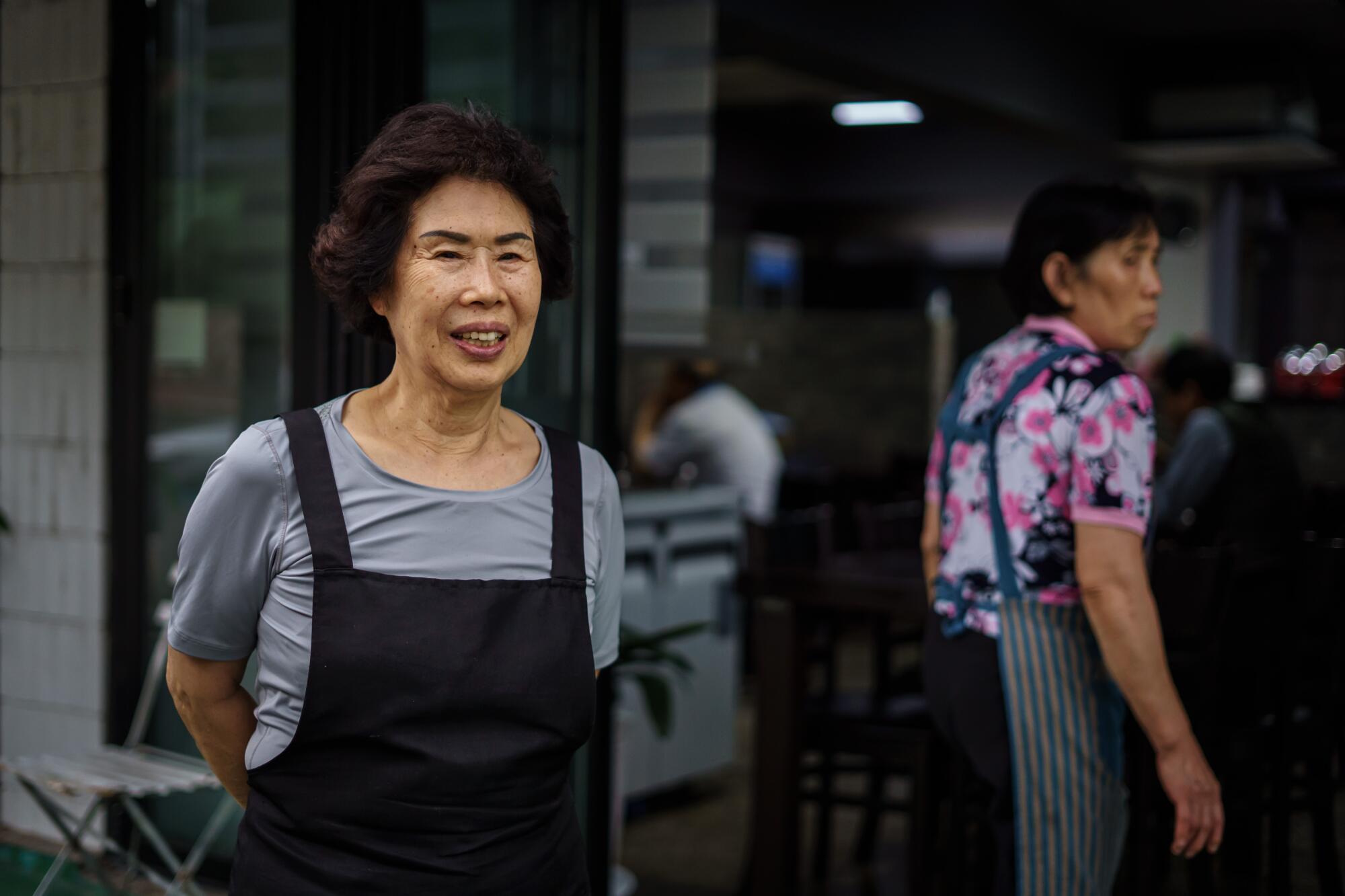
He has been driving a cab for 12 years and usually starts his days by driving toward Seoul Station in the heart of the city, because of its proximity to the restaurant. The owner, like him, is also from the southwest of South Korea, and since he discovered its familiar and comforting flavors, he rarely eats anywhere else.
Suh Keum-ja (no relation), started the restaurant, named after Suncheon, her hometown in South Jeolla province, in 1973 as a 24-year-old single mother with two young children. It was then a crumbling seven-seat hole in the wall with a leaky roof.
Over the decades, her restaurant burgeoned along with Seoul’s rapid growth and urbanization. She offered car washes outside the restaurant to attract customers, scrubbing taxis that came splattered with mud from the unpaved dirt roads that lined the city in the restaurant’s early days. As Suncheon grew in popularity, other driver restaurants cropped up nearby.
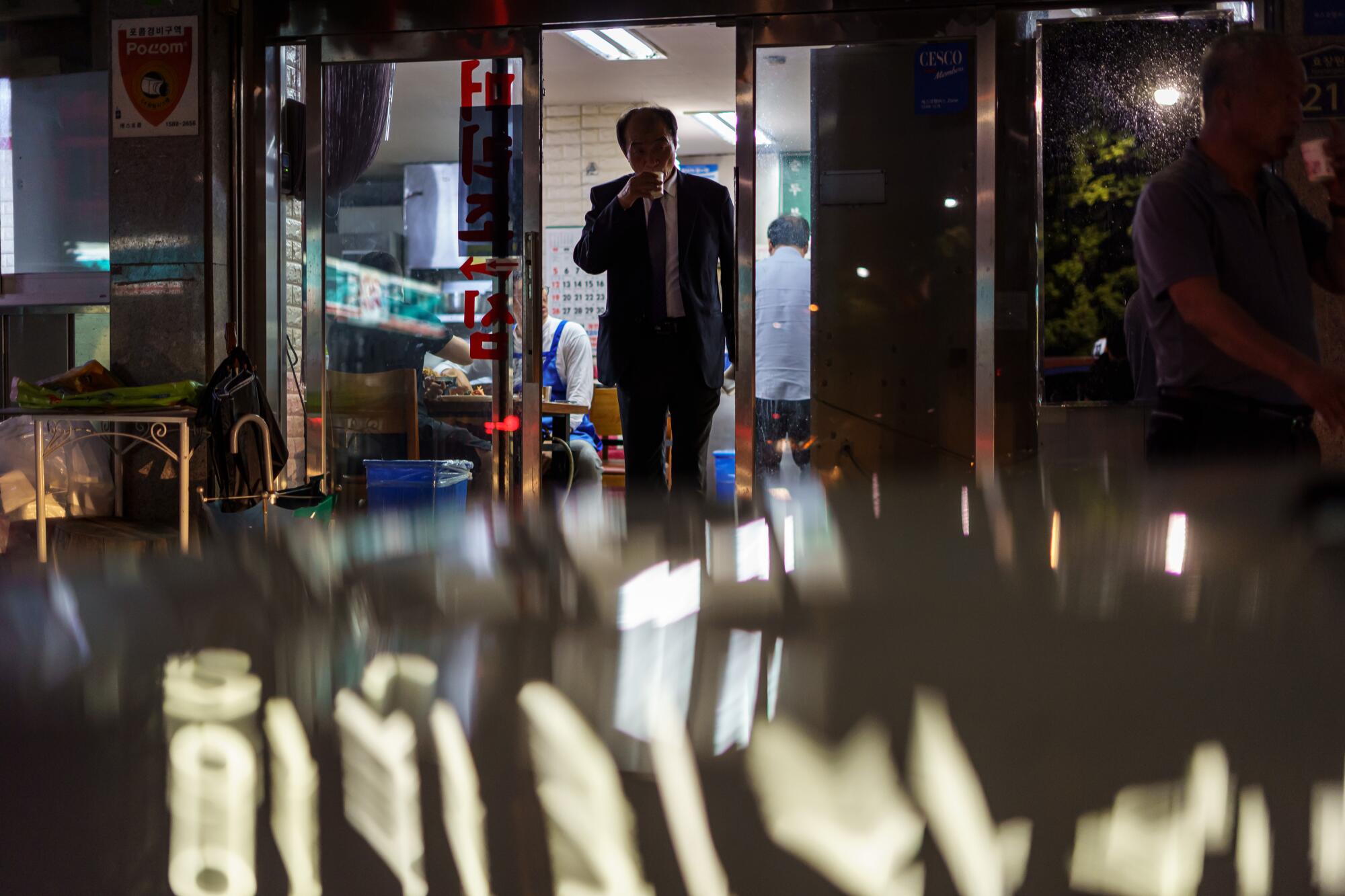
She’s now 71, and the restaurant three times its original size. She still cooks and seasons most of the dozen or so menu items herself, all priced at 7,000 or 8,000 Korean won — about $6 to $7. The base fare for a taxi ride in Seoul is 3,800 won.
Her customer base skews older, given the fewer and fewer young people wanting to join the ranks of a profession with long hours and meager earnings. Nine out of 10 cab drivers in Seoul are 50 or older — and in keeping with their palate, offerings at most gisa sikdangs hew to classic Korean dishes: bulgogi, grilled or braised fish and stews, and without fail, rice and kimchi.
In today’s Seoul, a bustling metropolis where older neighborhoods are constantly being torn down to make way for ever more high-rise apartments, driver restaurants are being squeezed out by rising rents and shifting tastes.
“Korea is all about change, and gisa sikdangs could be gone soon,” said Jason Kim, a Korean American food blogger who regularly seeks out driver restaurants. “When it’s gone, it’s going to be gone forever.”
::
Across town on a Friday night, Park Chil-baek lighted a cigarette outside his regular haunt, Woosung Gisa Sikdang, after a meal of pork bulgogi.
Spiffed up in creased white pants, his hair in a sparse pompadour and a gold watch gleaming from his wrist, the 69-year-old stretched his legs in what will be the only break of his 12-hour shift that ends at 3 a.m. The coming hours, as Friday night gives way to Saturday and the city’s drunken revelers stumble home, is make-or-break time for a cabdriver’s weekly balance sheet.
“I’ve been coming so long it feels like home,” said Park, who started driving a cab 33 years ago after his business selling industrial dyes went bust. He’ll often go out of his way to eat here — on this day, he drove through an hour of traffic from the suburbs for dinner.
Park and other drivers had roamed the hollowed-out streets of the city with empty cabs and mounting anxieties at the height of South Korea’s coronavirus outbreak earlier this year. A second gut punch came just as the city was coming back to life, when an outbreak started at a nightclub in early May.
“At other restaurants, you feel self-conscious. Here you know you belong.”
— Suh Joo-won, 67, taxi driver
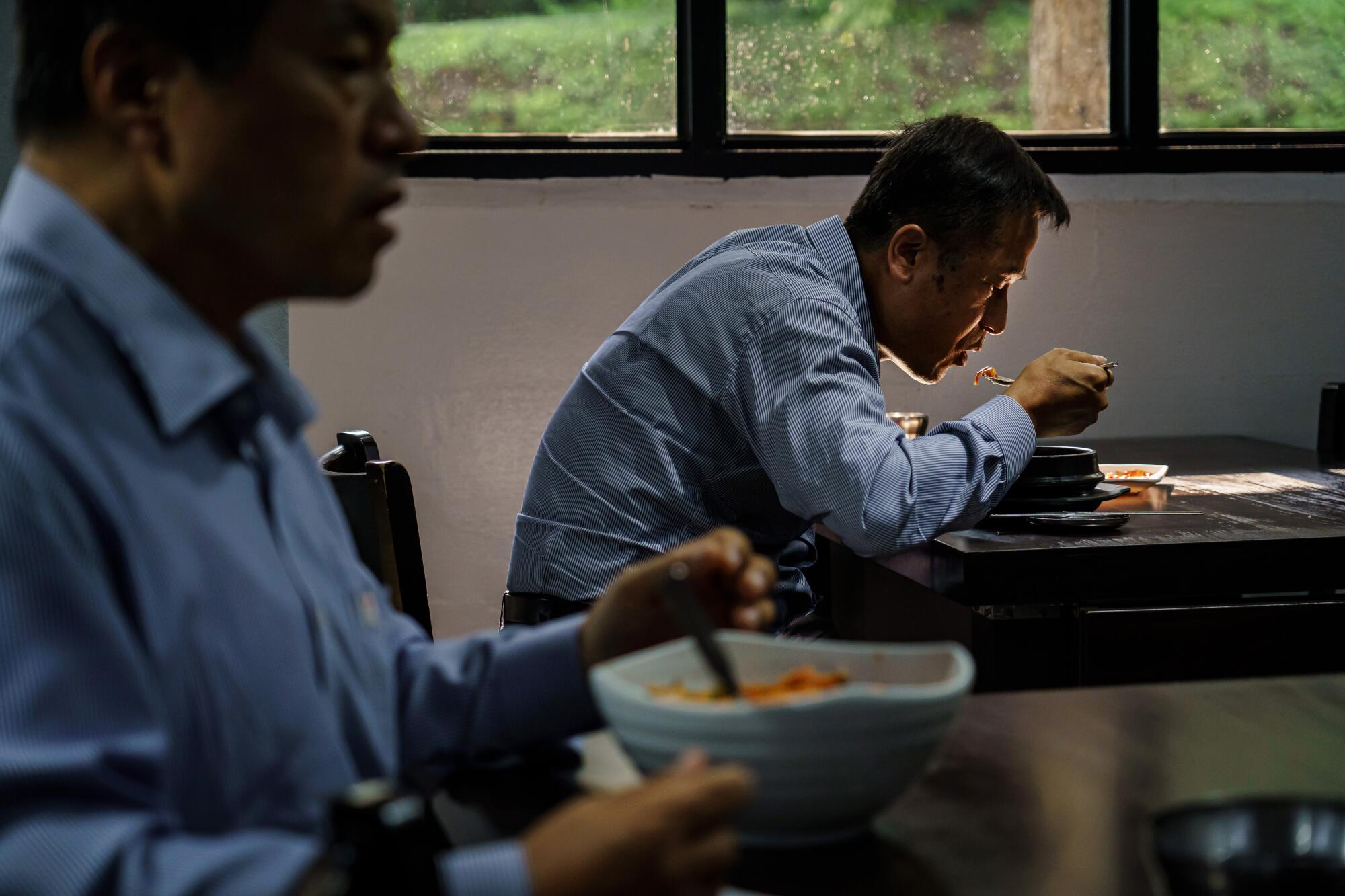
Mun Gong-sik, 68, said a hot meal at Woosung, where the rice is cooked in individual pots and topped with a colorful mix of squash, ginkgo nuts and beans, was a reliable comfort in a time of uncertainty.
“You come for a familiar face asking, ‘Did you make good money today?’” said Mun, stirring a steaming stone pot of cheonggukjang, a funky-smelling fermented bean stew.
For decades, Mun, who drives up to 18 hours a day, has been eating at Woosung twice or three times a week. Elsewhere in the city, he has a go-to seolleongtang, or ox bone soup, place in the southeast, a kimchi jjigae joint in the southwest, a fish stew shop in the west.
“As they say about cabdrivers,” he said, “I know Seoul roadways better than the lines on my wife’s palm.”
::
Kim Young-soon, 71, sat swatting mosquitoes at the cashier’s desk by the door at Ilsin Gisa Sikdang, famed for kimchi and bulgogi simmered in a broth that she wakes up daily at 3:30 a.m. to make.
On the table in front of her were rows and rows of stacked coins; bundles of 1,000-won bills filled a shelf below. For drivers, gisa sikdangs are more than just a lunch or dinner spot.
Many keep small change on hand so drivers don’t have to go to the bank; sell smokes at the counter to save them a trip to the store; and leave a bench or two out front for a post-meal smoke or coffee.
“Ninety-nine percent of our customers are regulars,” she said. “Some of them have been coming since we first opened.”
Kim pays the parking fine if a driver gets a ticket while eating at her restaurant, as many driver restaurants do.
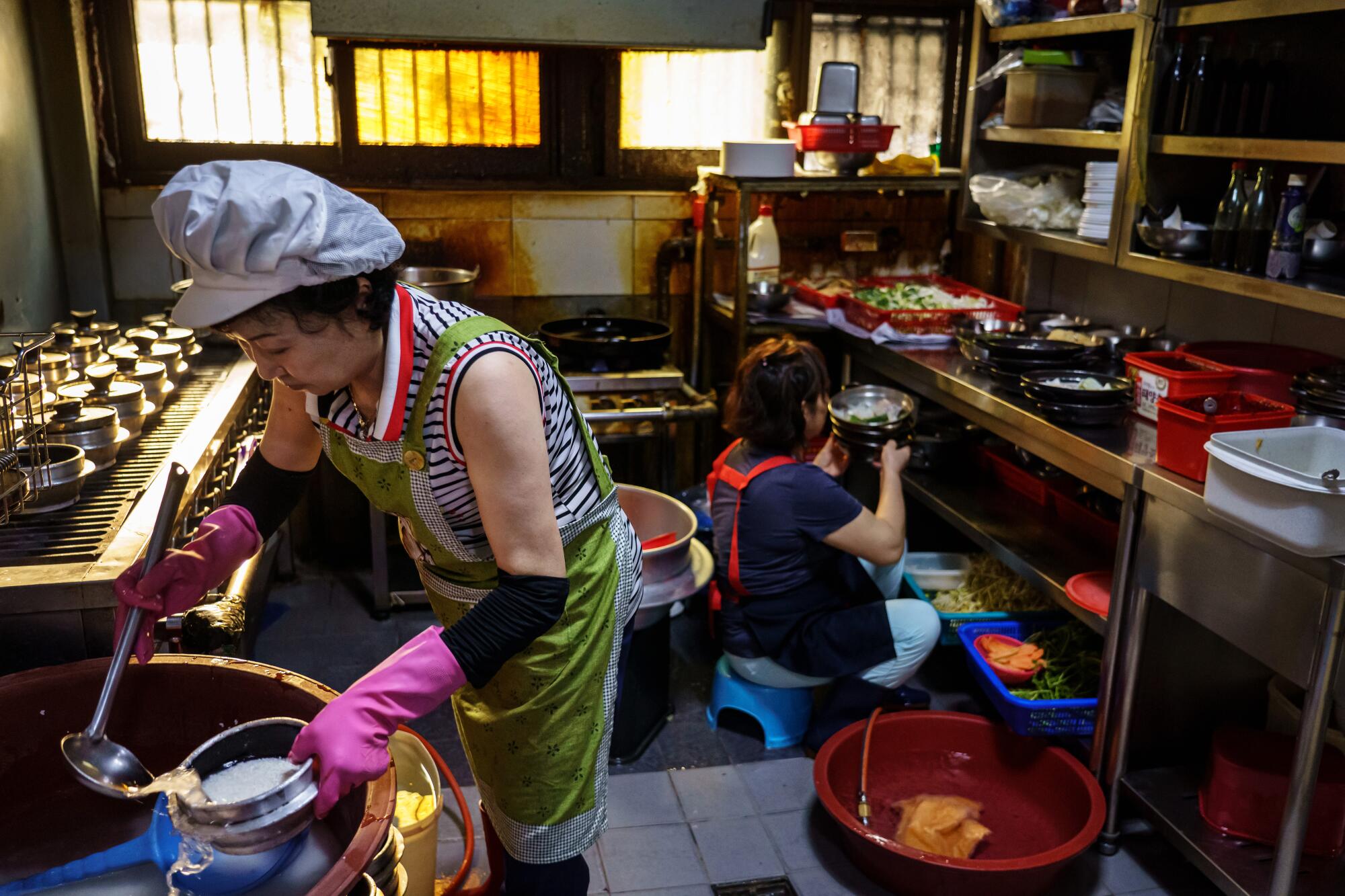
To her, it seems only right — it would take hours of driving to make up the 40,000 won (about $34) fine. Her son, who keeps watch for parking enforcement on the curb outside, estimated that over the years they’ve spent at least 100 million won, or about $84,000, footing the bill for drivers’ tickets.
Steam billowed over table after table of gas burners simmering kimchi and marinated pork, filling the air with a rich, sweet smell. Drivers eagerly piled meat and kimchi on crisp lettuce, stuffing the wraps into their mouths. Many walked over to an industrial-sized rice cooker to help themselves to another bowlful.
“You came early today,” Kim told a tall, lean driver, handing him his change. He asked about a fellow regular he hadn’t seen in a while, helped himself to a coffee, then walked out into the dusk, a toothpick dangling from his lips.
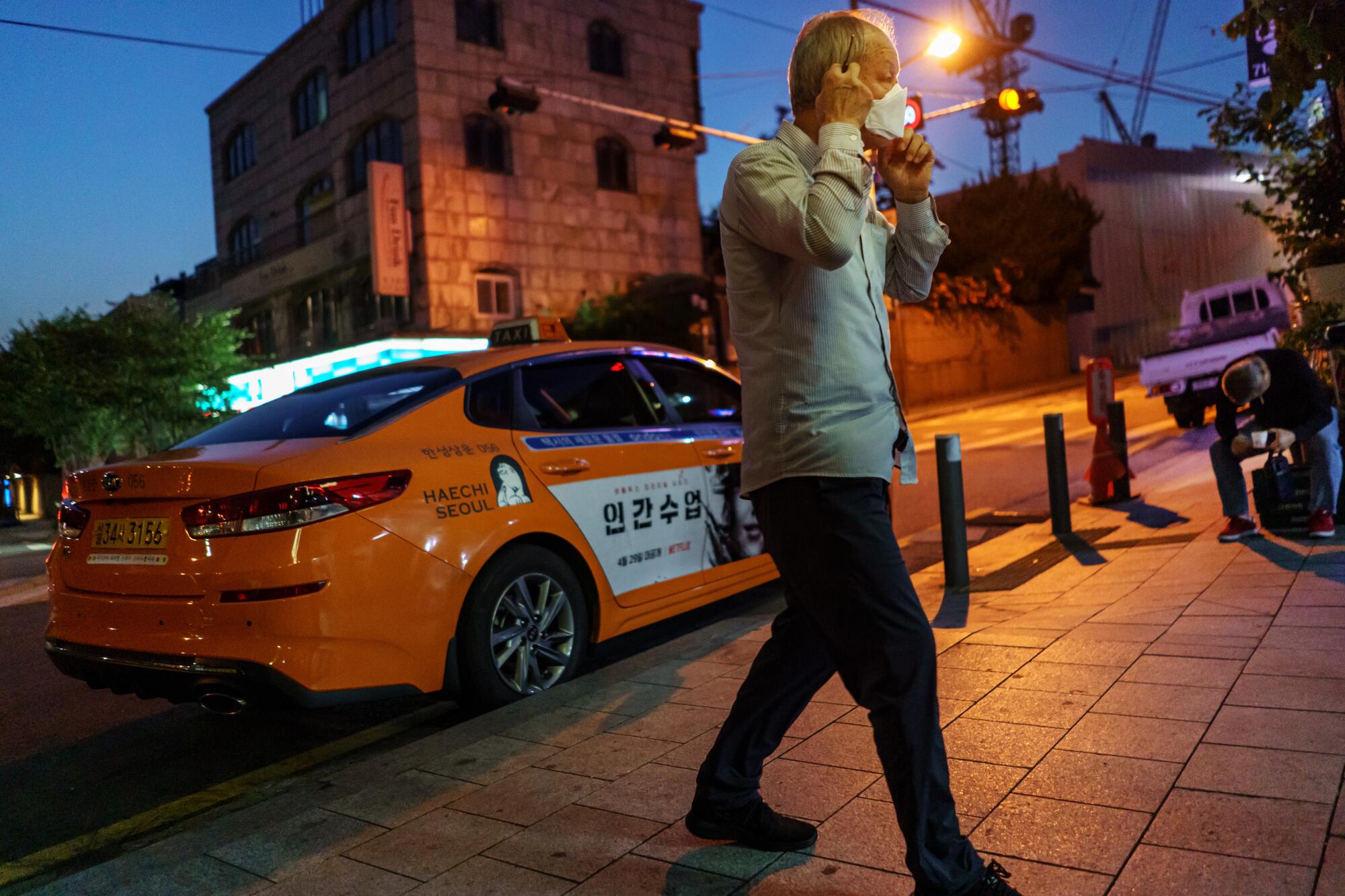
::
Shin, the 76-year-old driver at Suncheon, is considering hanging it up at the end of the year.
His daughter, worried about his health, has been imploring him to quit. From a poor, rural family that could only barely afford an elementary school education, he learned to drive in the military. Working first as a private chauffeur, then as a cabdriver, he raised two kids and put them through college.
“There were so few cars back then that it was a big deal to be a driver,” he recalled. “Benz, Cadillac, I’ve driven them all.”
He once drove 17 to 18 hours a day; it was hard to head home when more time on the road meant more income for his family. Over the years, some of his colleagues have died on the road of stroke and overwork.
These days, he takes it easy — for him. He drives from about 9 in the morning to 11 p.m.
And when he arrives for his late lunch at Suncheon, he lingers, enjoying every bite of his meal, gabbing with the owner about politics, savoring his instant coffee.
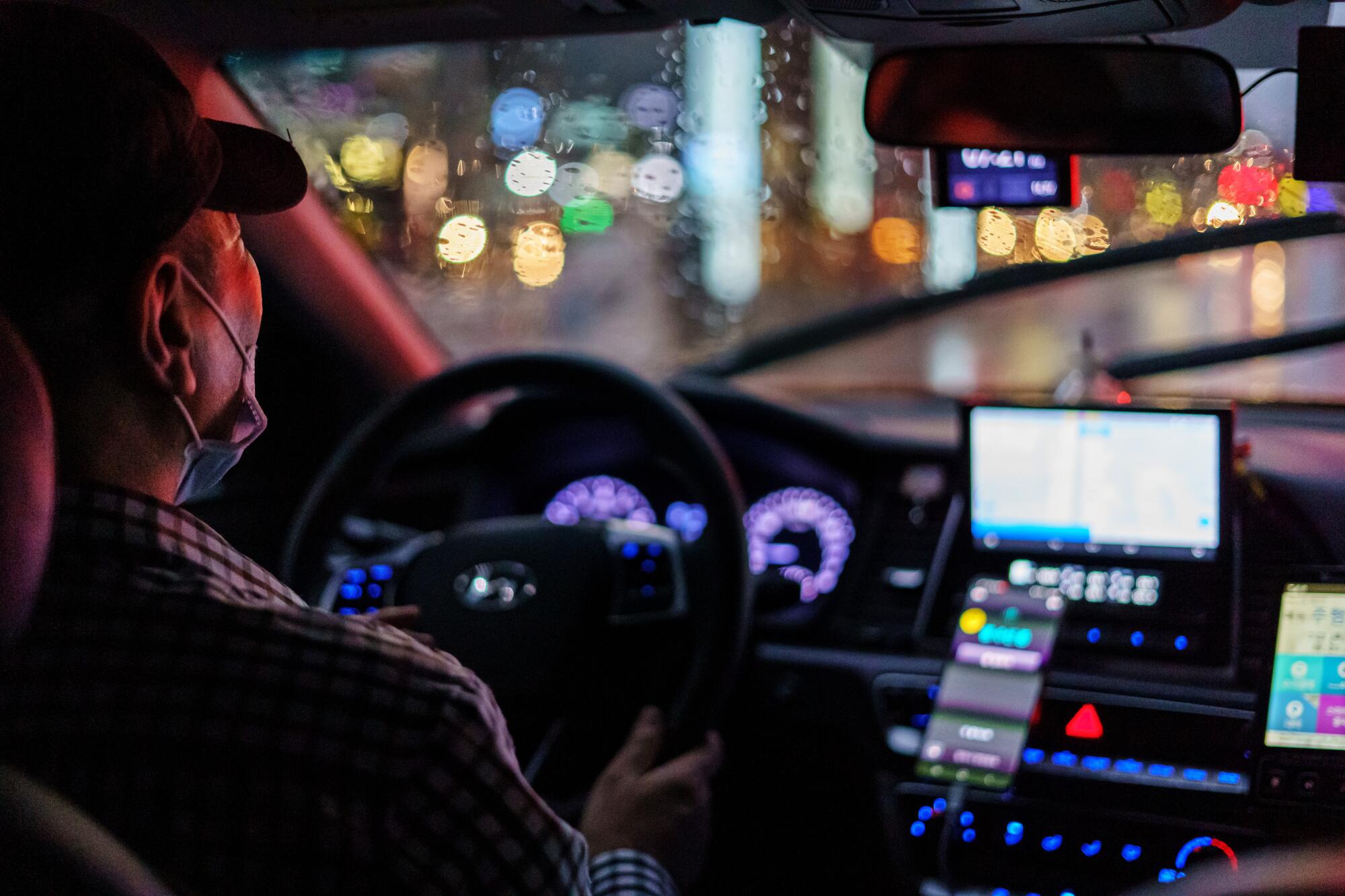
More to Read
Sign up for Essential California
The most important California stories and recommendations in your inbox every morning.
You may occasionally receive promotional content from the Los Angeles Times.



